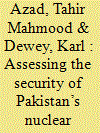| Srl | Item |
| 1 |
ID:
190865


|
|
|
|
|
| Summary/Abstract |
Although the broad outlines of Pakistan's nuclear weapons' programme are well documented, significant gaps remain in the understanding of the country's nuclear security regime. Nuclear security remains a highly politicised topic, with little robust information available regarding the steps taken to secure the country's nuclear assets. To help “fill the gaps”, this paper places official Pakistani documents, statements, and other open source information, into an analytical framework based on international standards of physical security. Although gaps in understanding remain, this paper finds that, in general, Pakistan has enacted robust security measures to protect its nuclear weapons and nuclear-weapons related infrastructure. Nonetheless, the prevailing perception of Pakistan's nuclear security remains dominated by embarrassing episodes that emphasise the importance of effective nuclear security culture. Based on its findings, this paper also offers policy recommendations which may offer additional confidence about the rigours of the country's nuclear security regime.
|
|
|
|
|
|
|
|
|
|
|
|
|
|
|
|
| 2 |
ID:
193256


|
|
|
|
|
| Summary/Abstract |
This study examines the dynamics of gray zone warfare by analyzing its conceptualization in the literature and through its practice in several recent examples. Ever-increasing changes in the characteristics of contemporary warfare have complicated the security environment of the 21st century. Modern warfare inclines toward non-kinetic dimensions based on the principles of hybridity, soft power, and ambiguity. This changing nature of warfare has been defined and categorized in diverse ways, leading to numerous perspectives revealing more confusion than clarity. The terms “hybrid warfare,” “gray zone warfare,” “unrestricted warfare,” and “ambiguous warfare” have received unprecedented attention in recent years. A key contemporary challenge is to differentiate between war and peace because gray zone warfare occupies the space in between both these situations. Many contemporary conflicts are neither black nor white; instead, they fall in the middle of the two: the gray zone. These factors underscore the significance of evaluating and understanding the concept of gray zone warfare. The United States considers Russia, China, and Iran as revisionist states that employ gray zone warfare in various domains to challenge the United States-led world order. South Asia is also a manifested playground of gray zone warfare. The research further distinguishes between gray zone warfare and hybrid warfare and proposes strategies for countering this threat.
|
|
|
|
|
|
|
|
|
|
|
|
|
|
|
|